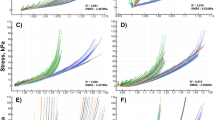Abstract
We present an automatic adaptive procedure to perform blood flow simulations in the cardiovascular system. The procedure allows the user to start with subject-specific data collected through clinical measurements, like magnetic resonance imaging (MRI) data, and evaluate physiological parameters of interest, like flow distribution, pressure variations, wall shear stress, in an automatic and efficient manner. The process involves construction of geometric models of blood vessels, specification of flow conditions and application of an adaptive flow solver. The latter is based on incompressible Navier–Stokes equations using adaptive spatial discretization (meshing) techniques. In this article, we demonstrate the method on a model of a human abdominal aorta of a normal subject with geometry and flow rates assimilated from MRI data. The results obtained show that boundary layer mesh adaptivity offers a better alternative leading to more accurate predictions, especially for key physiological quantities like wall shear stress.












Similar content being viewed by others
References
Ku DN (1997) Blood flow in arteries. Annu Rev Fluid Mech 29:399–434
Taylor CA, Draney MT (2004) Experimental and computational methods in cardiovascular fluid mechanics. Annu Rev Fluid Mech 36:197–231
Perktold K, Resch M, Peter RO (1991) Three-dimensional numerical analysis of pulsatile flow and wall shear stress in the carotid artery bifurcation. J Biomech 24:409–420
Moore JA, Rutt BK, Karlik SJ, Yin K, Ethier CR (1999) Computational blood flow modeling based on in vivo measurements. Ann Biomed Eng 27:627–640
Taylor CA, Hughes TJR, Zarins CK (1998) Finite element modeling of blood flow in arteries. Comput Meth Appl Mech Eng 158:155–196
Taylor CA, Draney M, Ku J, Parker D, Steel B, Wang K, Zarins C (1999) Predictive medicine: computational techniques in therapeutic decision-making. Comput Aided Surg 4 (5):231–247
Stuhne GR, Steinman DA (2004) Finite-element modeling of the hemodynamics of stented aneurysms. Trans. ASME J Biomech Eng 126(3):382–387
Steinman DA, Taylor CA (2005) Flow imaging and computing: large artery hemodynamics. Ann Biomed Eng 33 (12):1704–1709
Friedman MH, Giddens DP (2005) Blood flow in major blood vessels-modeling and experiments. Ann Biomed Eng 33(12):1710–1713
Figueroa CA, Vignon-Clementel IE, Jansen KE, Hughes TJR, Taylor CA (2006) A coupled momentum method for modeling blood flow in three-dimensional deformable arteries. Comput Meth Appl Mech Eng 195:5685–5706
Vignon-Clementel IE, Figueroa CA, Jansen KE, Taylor CA (2006) Outflow boundary conditions for three-dimensional finite element modeling of blood flow and pressure in arteries. Comput Meth Appl Mech Eng 195:3776–3796
Garimella RV, Shephard MS (2000) Boundary layer mesh generation for viscous flow simulations. Int J Numer Meth Eng 49:193–218
Sahni O, Müller J, Jansen KE, Shephard MS, Taylor CA (2006) Efficient anisotropic adaptive discretization of the cardiovascular system. Comput Meth Appl Mech Eng 195:5634–5655
Tang BT, Cheng CP, Draney MT, Wilson NM, Tsao PS, Herfkens RJ, Taylor CA (2006) Abdominal aortic hemodynamics in young healthy adults at rest and during lower limb exercise: quantification using image-based computer modeling. Am J Physiol Heart Circ Physiol 291(2):H668–H676
O’Bara RM, Beall MW, Shephard MS (2002) Attribute management system for engineering analysis. Eng Comput 4:339–351
Shephard MS, Beall MW, O’Bara RM, Webster BE (2004) Toward simulation-based design. Finite Elem Anal Des 40:1575–1598
Ainsworth M, Oden JT (2000) A posteriori error estimation in finite element analysis. Wiley, New York
Verfürth R (1996) A review of posteriori error estimation and adaptive mesh-refinement techniques. Teubner-Wiley, Stuttgart
Bänsch E (1991) Local refinements in 2 and 3 dimensions. Impact Comput Sci Eng 3:181–191
de Cougny HL, Shephard MS (1999) Parallel refinement and coarsening of tetrahedral meshes. Int J Numer Meth Eng 46:1101–1125
George P-L, Borouchaki H, Laug P (2002) An efficient algorithm for 3D adaptive meshing. Adv Eng Softw 33:377–387
George P-L (1999) Tet meshing: construction, optimization and adaptation. In: Proceedings of eighth international meshing roundtable, South Lake Tao
Kunert G (2002) Toward anisotropic mesh construction and error estimation in the finite element method. Numer Methods Partial Differ Equ 18:625–648
Borouchaki H, George P-L, Mohammadi B (1997) Delaunay mesh generation governed by metric specifications. Part II. Applications. Finite Elem Anal Des 25:85–109
Sahni O, Jansen KE, Shephard MS, Taylor CA, Beall MW (2008) Adaptive boundary layer meshing for viscous flow simulations. Eng Comput 24:267–285
Brooks AN, Hughes TJR (1982) Streamline upwind/Petrov–Galerkin formulations for convection dominated flows with particular emphasis on the incompressible Navier–Stokes equations. Comput Meth Appl Mech Eng 32:199–259
Whiting CH, Jansen KE (2001) A stabilized finite element method for the incompressible Navier–Stokes equations using a hierarchical basis. Int J Numer Meth Fluids 35:93–116
Jansen KE, Whiting CH, Hulbert GM (1999) A generalized-α method for integrating the filtered Navier–Stokes equations with a stabilized finite element method. Comput Meth Appl Mech Eng 190:305–319
Shakib F http://www.acusim.com
Li X, Shephard MS, Beall MW (2003) Accounting for curved domains in mesh adaptation. Int J Numer Meth Eng 58:247–276
Acknowledgments
We gratefully acknowledge the support of this work by NSF grants ACI-0205741 and 0749152. We would also like to acknowledge that some of the computations carried in this study were performed on parallel computers obtained through NSF grant 0420703. The results presented in this article made use of the linear algebra library provided by ACUSIM Software Inc. The attribute management system used in this study was provided by Simmetrix Inc.
Author information
Authors and Affiliations
Corresponding author
Rights and permissions
About this article
Cite this article
Sahni, O., Jansen, K.E., Taylor, C.A. et al. Automated adaptive cardiovascular flow simulations. Engineering with Computers 25, 25–36 (2009). https://doi.org/10.1007/s00366-008-0110-5
Received:
Accepted:
Published:
Issue Date:
DOI: https://doi.org/10.1007/s00366-008-0110-5




